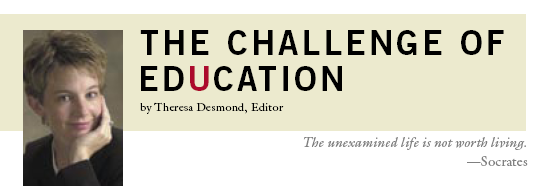
| Vol. 14 No. 2 | Fall 2004 |

It’s safe to say that some recent remarks by a couple of Utah lawmakers caught the attention of folks at the University.
In May, The Salt Lake Tribune ran a story in which Rep. Bradley Johnson, co-chair of the Higher Education Appropriations Subcommittee, noted, in reference to the University, “We put a lot of resources in our schools; we don’t want them teaching something we don’t believe in.” (He explained, “Part of it is our religion and part of it is our pioneer heritage.”) Another member of the Higher Education Appropriations Subcommittee, Sen. David Gladwell, observed, “It’s not the job of a university to challenge the local culture. It’s to educate the community.”
Whatever questions those comments might have raised for others at the U, they caused me to think that the us-vs.-them, University-vs.-“local culture” conversation, which itself seems to be a longstanding Utah tradition, seems ready for retirement.
Hopefully, most of the U’s 200,000 alumni have found that immersing oneself, as a student, in intellectual traditions, and the challenges within and to them, is not so much learning what to believe but how we come to believe. Becoming a better problem-solver and a creative thinker—that is, becoming educated—means understanding a broad range of approaches and ideas.
In my conversation with U’s new president, Michael K. Young ("Go West, Young Man"), he noted that what happens in the classroom—especially in a diverse classroom—is not an affirmation of beliefs, whatever they are, but a challenge to the intellect. “Kids teach each other,” he said, “so they need other students and professors with different mindsets and backgrounds. You don’t want to force them to believe anything, but you do want to expand their analytical capacity. It’s critical.”
A glance at Professor Meg Brady’s work ("West Side Stories") indicates the complexity of that learning process. Brady, an English and ethnic studies professor and folklorist, created a service-learning course last year that taught students how to take oral histories—which they did, of residents of the Multicultural Senior Center, transcribing the residents’ words and eventually presenting printed and bound life stories to the residents.
The students learned how stories are created— how events are filtered through memory and experience and emotion to become part of personal “history.” Like all of us, interviewees tell the truth of their lives—as they perceive it. As William Faulkner put it, in Light in August, “Memory believes before knowing remembers. Believes longer than recollects, longer than knowing even wonders.”
When the subjects are given a transcription of the stories they have told, they are, in effect, confronted with the version of their lives they have created. They read their own words, seeing, perhaps for the first time, the ways they have constructed events and beliefs and assumptions—and not seeing what they have chosen not to talk about. Reading one’s own words can be an out-of-body experience; the life described appears different in print than in reality. Almost always, that process causes reflection and questioning.
And that’s what a good teacher like Brady does in the classroom: causes students to confront, directly or indirectly, the ways they understand themselves and the world. The goal is not to change beliefs but to expose students to the world of beliefs. In the classroom, our perceptions, like transcriptions of our oral histories, are presented to us in a new format. We learn to examine what we think we know, in the context of understanding other ways of knowing.
And indeed, those conversations can be volatile; as Ann Darling, professor of communication, has noted, learning is “the only essential act of violence.”
But surely, at a university—of all places—there is room for a little learning.